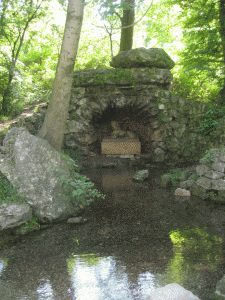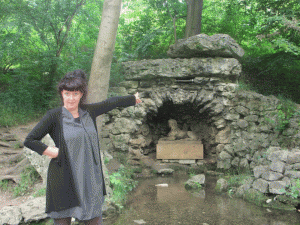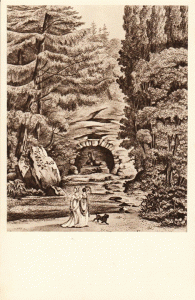Klauer, Martin Gottlieb 1(1742-1801) ‘Sphinxgrotte’ (sphinx cave) 1786, sandstone in travetin cave architecture, Park an der Ilm, Weimar (replica, original in the Roman House)
foto: Klaas Herman Knol
A sphinx in a grotto. It is part of the eighteenth-century tradition in Weimar where a park of 48 hectare was realized. In order to give a harmonious experience of nature meeting culture, a snakestone (1787), three columns (1788) and a ‘Roman house’ (1791-98) were realised. It followes the tradition of the ‘jardin pittoresque’, the pittoresque garden, that developed during the second half of the sixteenth century. The meeting with culture on unexpected places according to a well coordinated plan, was full of literary suggestions, often referring to mythology. Meeting the sphinx, would result in a moment of contemplation for the wanderers.
How it was supposed to work, can be seen in a fine work by Georg Melchior Kraus, a friend of Goethe, where two ladies can be seen on the back, while walking up the sphinx. Thety are dressed in the new fashion of classical white dresses with an elegant high waistline.
For more Weimar related post cards, click here.
Kraus, Georg Melchior (1737-1806), ‘Grotte der Sphinx im Park bei Weimar‘, mezzotint Bruckmann

The sphinx is from the pharaonic prototype, but more relevant is its placement in a cave. It became a bit of a traditions, since in painting Ingres placed his sphinx in a cave and ‘The Great Sphinx’ of the Louvre also houses in a cellar for years.
The sphinx is placed over water, indicating the Leutra-spring, a karst-spring rising from the geological Ilmtal-ditch.* here are three exits of the Leutraspring which in the design of the Ilmpark have been integrated, after a few meters, the springwater flows into the Ilm.
Literature:
* Taylor, Patrick, The Oxford companion to the garden. Oxford, 2006, p.232
Müller-Wolff, Susanne, Ein Landschaftsgarten im Ilmtal: die Geschichte des herzoglichen Parks in Weimar. Cologne/Weimar: Böhlau Verlag, 2007, pp.152-53
Website:
Click here for the website



